Clothes don’t make the man but they go a long way toward making a businessman.
Pack your todays with effort – extra effort! Your tomorrows will take care of themselves. They will also take care of you and your money.
You cannot be a success in any business without believing that it is the greatest business in the world. You have to put your heart in the business and the business in your heart.
We have different ideas, and different work, but when you come right down to it, there is just one thing we have to deal with throughout the whole organization-that is MAN.
Thomas Watson, Sr., former chairman, IBM Corporation
Who hasn’t heard of IBM? The direct descendant of Herman Hollerith’s Tabulating Machine Company, it is the fifth largest industrial corporation in America and the world’s biggest computer manufacturer. To a large degree – a degree that warms the hearts of its shareholders and distresses its competitors – IBM is the computer industry, and almost every other computer company in the world swims in its ocean. It commands about 40 percent of the international computer market, producing approximately three fourths of all medium- and large-size computers and one fourth of all personal computers. It also makes typewriters, automatic teller machines, supermarket checkout registers, subway ticket dispensers, marine navigation equipment, and dozens of other products.

IBM is very much the creation of two men, Thomas J. Watson, Sr., who ran the firm from 1914 until the early 1950s, and his eldest son, Thomas Jr., who was in charge from 1952 to 1971. The elder Watson, an autocratic executive and master salesman, built IBM into one of the strongest and most profitable companies in the country. But he was in his late seventies in the early 1950s, more interested in preserving what he had created than in forging new ground, and he had little feel for computers. Although IBM’s chief competitor, Remington Rand, had bought out Eckert and Mauchly in 1950, Watson was unwilling to follow Rand’s lead. At that time, computers were huge, expensive machines, with seemingly little commercial potential. His son, on the other hand, belonged to the generation that had invented ENIAC, and he possessed an instinctive grasp for this new technology. With his father’s grudging permission, Tom moved IBM into computers. And by 1955, three years after Tom had assumed the presidency, the company’s revenues had doubled.